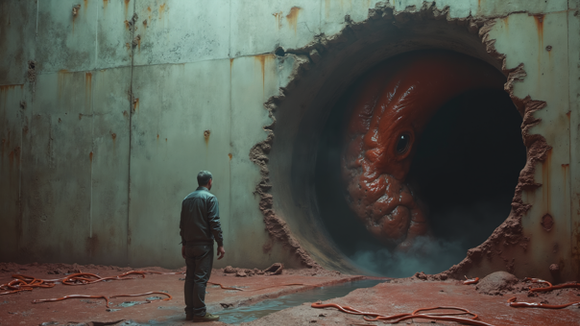HOME | DD
 LHS3020b — The Final Hour of Alpha Exelsis
LHS3020b — The Final Hour of Alpha Exelsis

#giant #progenitor #red #space #star #supernova #art
Published: 2023-11-11 18:01:00 +0000 UTC; Views: 873; Favourites: 13; Downloads: 1
Redirect to original
Description
At only 3.07 parsecs, Alpha Exelsis was one of New Innsmouth and Dagon's closest stellar neighbours. It was also the brightest star in New Innsmouth's night sky - indeed, it was actually bright enough that you could easily see it by daylight too, as the star's apparent magnitude was brighter than the background sky-glow.Then, in 70 PE, it exploded.
The star was a red supergiant; it would have originally been an O6-type object during its short Main Sequence life span. Originally weighing in at around 37 solar masses, it would have burned its nuclear fuel very fast, exhausting the hydrogen at its core within only a few million years. The star's core would have moved onto first burning helium, then carbon, neon, oxygen and even eventually silicon - in fact its interior would have ended up layered as an onion, burning successively-heavier chemical elements the deeper you go.
Unfortunately, heavier nuclei become less and less useful, requiring more energy to get them to fuse while giving less back. Each stage of fusion was less effective at supporting Alpha Exelsis against its own weight, and each new element supplied the star with energy for less and less time. When the star finally tried to burn silicon, this would have been sufficient for less than 24 hours - compare this to hydrogen, which can keep a solar-mass star stable for around ten billion years!
The final stage beyond silicon burning is iron fusion. Technically, iron will fuse - under sufficient temperatures and pressures, the nuclei can merge. However, iron fusion actually consumes more energy than it releases, and thus it actually cools the star's interior down. This is, of course, catastrophic, as thermal pressure is what's supporting the star against the force of its own weight.
On that fateful day in 70 PE, Alpha Exelsis tried to burn iron, and this had entirely-predictable consequences. It would have taken the star's core about 1.4 seconds to collapse under the force of its own gravity, atomic nuclei being crushed together and protons and electrons forced to merge into neutrons. Abruptly-unsupported, the star's upper layers caved in on the core, then rebounded. Their collision in on themselves drove extreme temperatures and pressures, ironically causing a massive eruption of turbulent nuclear fusion. The star essentially turned itself into a gigantic nuclear bomb, first imploding and then exploding.
Supernovae are some of the most powerful energetic events in the Universe; at peak candescence, Alpha Exelsis literally outshone the rest of the Milky Way combined. Its explosion will eventually be visible over literally billions of parsecs.
The star's instability was, of course, already well-known. While there are many open questions linked to it, nonetheless the astrophysics of supernovae had been broadly-understood for around half a millennium previously. The star had been recognised as a potential hazard to navigation for some time. In fact, the Human Colonial Federation, in one of the few useful achievements that organisation had ever made, had actually placed some monitoring beacons in orbit around the star, linked together via comms-class wormhole throats. They were at differing orbital distances, the idea being that once the star collapsed, this could be confirmed by the sequential failure of the beacons.
(Interestingly, in the late 50s PE the star was actually considered as a possible site for the funeral of Elspeth Okani, though at the time Delta Calixis "won" due to its obviously-more-imminent instability.)
On that morning in 70 PE, the beacons failed one after another, in exactly the sequence that lightspeed delay from the star demanded. However, there was another, unintended event.
The beacons relayed themselves to the Exile-wide communications networks via a connection located in the New Innsmouth system. The Dagon-based end of this comms-class throat orbited (fortunately) some distance away from the planet itself. No-one had considered the possible perils of this arrangement as under normal circumstances, there were none!
However, during Alpha Exelsis's explosion, every square centimetre of the local throat's surface was receiving around 2.5 times as much energy per second as the whole of New Innsmouth received from Dagon in a year. The aperture of both throats was, thankfully, small, but even then the transmitted luminosity was significant. For a lot of people on New Innsmouth, the first sign that anything was wrong was when there were suddenly two suns in the sky. The second sign that anything was wrong was the abrupt rise in temperatures across the exposed hemisphere; the throat was supplying so much energy that it actually added around 22 degrees of heating across the planet. Normally a rather-cold place, New Innsmouth abruptly found itself handed a tropical climate, driving concomitant weather chaos.
The next sign that anything was wrong came in the form of widespread disruption to communications and transportation, as hard X-rays from Alpha Exelsis interacted with New Innsmouth's ionosphere to produce an EMP-like effect. (On the plus side, the acoompanying aurorae were pretty, and bright enough that they could be seen by daylight, and even at low lattitudes.)
NIDA was taken entirely by surprise by the wormhole's partial transmission of supernova candescence. They had obviously been aware of Alpha Exelsis's presence and its instability, but had done no contingency planning whatsoever for its collapse. (That would, after all, remove money from the pool that supplied managerial bonuses.) While the supernova-driven false sun declined from its initial peak over the next few weeks, the disruption to normality continued. Notably, the supernova chaos was a large factor in how the Kedrianos uprising was able to stabilise and expand itself. The various rebel groups in the city proved better-able to respond to the stellar disaster, and their more-effective public response went some way to consolidating popular support behind them.
But, Alpha Exelsis wasn't finished with the Dagon system yet.
Even while the wormhole-illumination declined, the main explosion was propagating through space at the speed of light. It took around 10 years to reach Dagon. When it did, another second sun erupted in New Innsmouth's sky, bringing with it a surge of hard radiation which caused chaos for space-based sensor systems. Again, amazingly, the corporation was caught on the hoop, having failed to plan for the arrival of the actual supernova itself. By this point the anti-corporate rebellion on New Innsmouth was much further advanced, and to many people the Union was looking plausible as an alternative governing authority. The Union forces were aware that the supernova shockwave was coming, and in fact had planned for it. They used the chaos it caused as cover for their attack on NIDA's orbiting shipyards, and it was this assault that finally gave the Union a full aerospace engineering capacity. Once it was in control of the shipyards, this paved the way for the successful attack on the Moon the following year, and the end of the war.
Had the corporation bothered to do any planning for a well-known and well-forecast natural disaster, it's quite possible the war could have gone differently. However, NIDA's internal culture of greed, anti-intellectualism and managerial backstabbing ensured that warnings could not be effectively-raised, nor could they be effectively-acted on. Much as Alpha Exelsis's own physical nature eventually doomed the star to destruction, so did NIDA's internal constitution ultimately doom it to its well-deserved fate.

























